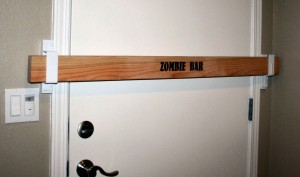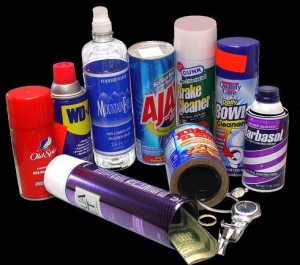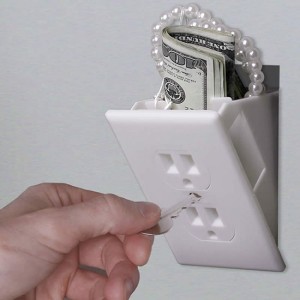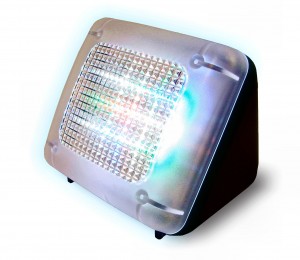Your interior zone is everything inside the walls of your house. If an intruder has bypassed all of the layers you’ve placed so far, there’s no reason to make things easy now. There are more layers you can lay down that will continue to delay the intruder, hopefully long enough for witnesses to report them or the police to arrive.
Door Blockers
 Door blockers are an inexpensive way to kick-proof your doors by putting some kind of substantial reinforcement on the inside. The simplest is called the “Zombie Bar”, and is simply a 2×4 braced across the inside door frame that prevents the door from opening.
Door blockers are an inexpensive way to kick-proof your doors by putting some kind of substantial reinforcement on the inside. The simplest is called the “Zombie Bar”, and is simply a 2×4 braced across the inside door frame that prevents the door from opening.
There are a number of other approaches, to include a steel block inset into the floor and wedges that fit into the frame. Door blocks work well and take a considerable amount of time to defeat. The only downside is that they have to be installed from the inside, so when you’re not home at least one of your doors is not kick proof. They also take effort to insert and take apart, which some people find tedious and forget.
Safe Rooms
A safe room is where you make your last stand. It is usually your bedroom since that’s where you spend the majority of your time. If you detect a break-in your objective is to gather your family into the safe room and barricade it. Most safe rooms have a reinforced door, not the common hollow core pieces of junk that most homes come with. The door should equal your front door in terms of strength, have at least one good lock, and a solid, kick-proofing barricade installed. You have to assume that any intruder that is still chasing you after breaking in is out to do physical harm and will aggressively try to access your safe room. Plan on this when designing your safe room and build in as many security measures as you can afford. If the day ever comes when someone is kicking your door from the outside, you won’t regret spending that extra $100, and your wife will no longer care about the aesthetics of that “ugly door”.
Weapons
Guns are a highly sensitive subject and I won’t go into recommendations here. Suffice to say a weapon can end a standoff very quickly. It can also escalate a situation just as quickly if the intruder thought to bring his own gun. Fortunately, most thieves don’t have murderous intent – they just want valuables – and will avoid confrontation, especially cornered, armed homeowners that are protecting their family. Nothing ends a fight faster than sound of a 12 gauge racking a shell into the chamber.
If you choose to arm yourself you’ll need to consider how to secure the weapon, prevent little hands from finding it, and how you will use it if the time ever comes. Think it through and play out every scenario you can imagine in your head before you try grabbing a handgun in the middle of the night.
Safes
Years ago I went shopping for a gun safe and found a reputable dealer at a local gun show. After discussing my needs we made an appointment to meet at his warehouse the following week. I arrived to find wide selection of makes and models to choose from. He talked me through the details, such as resistance time, fire resistance, number of locking bars – all that interesting stuff – and I ultimately chose a large top-of-the-line safe. While in his office filling out the paperwork and handing over my credit card he casually asked “so, how many guns did you lose?” I gave him a strange look and replied “none, why do you ask?” He got a look of relief and told me that I was one of the few buyers he’d ever had that bought a safe before having everything stolen. “Most people buying my safes no longer have anything to lock up” he told me.
On another investigation a homeowner had suffered a break-in and was showing us the damage. The criminals had literally pulled out drawers and dumped everything, even in the kitchen. As we were walking through the bedroom taking photographs I noticed a large open safe in a closet and said “well, at least you didn’t lose everything”. He gave me a sheepish look and said “They emptied it. My wife kept her jewelry in it and habitually left it open because she didn’t like bending over to punch in the combination every time she wanted something.”
Safes will delay thieves for a very long time if they are locked and bolted down to the floor. A fire safe is not a safe. It’s a plastic box with plaster filled walls that is only designed to protect documents against fire. Safes are hardened steel with a combination lock. This is not a lesson in buying safes but suffice to say you want a safe with thick, hardened steel construction and at least six locking bars securing the door. It should weigh at least 300 pounds and be bolted solidly to the floor to prevent it from being carried away while locked. Dial combination locks are archaic and a pain in the butt to use. That is one of the main reasons people leave them open. Instead, pay a little more for a digital keypad and electronic lock. These can be opened easily and quickly in less than 5 seconds.
Oh, and you should have a house rule: If you unlock it, lock it before walking away.
Hidden valuables
 Most people think they can hide their valuables under their mattresses, in a shoebox in their closet, or in the back of a bureau drawer. Criminals are not stupid. They KNOW about those, and many other places. They know to look in the refrigerator and freezer for jewelry and drugs. They’ve seen those fake cans of soup with the screw-off lid and are on the lookout for them. They look under your bed, in your bedside dresser, and in the corners of your closets for your guns. They know that people hollow out the tops of doors to put jewelry in. Taping cash to the bottom of drawers or behind pictures is very common. Criminals even memorize what those fake rocks look like that people hide their keys in. Using these ideas to hide things is futile and get your stuff ripped off.
Most people think they can hide their valuables under their mattresses, in a shoebox in their closet, or in the back of a bureau drawer. Criminals are not stupid. They KNOW about those, and many other places. They know to look in the refrigerator and freezer for jewelry and drugs. They’ve seen those fake cans of soup with the screw-off lid and are on the lookout for them. They look under your bed, in your bedside dresser, and in the corners of your closets for your guns. They know that people hollow out the tops of doors to put jewelry in. Taping cash to the bottom of drawers or behind pictures is very common. Criminals even memorize what those fake rocks look like that people hide their keys in. Using these ideas to hide things is futile and get your stuff ripped off.
If you want to hide your valuables you’ll need to be very creative. Secret compartments in antique furniture is excellent – if you can find it. A buddy has an antique roll top desk with three hidden compartments and it’s fantastic for hiding pretty much anything.
 Another friend has a microwave with a Velcro attached back. It has plenty of room in the hollow space behind for three handguns. I’ve seen hollowed out bedposts, removable wall panels, fake electrical service panels, holes in the wall behind pictures and mirrors, fake wall sockets and light switches, removable floor boards, and many other hiding places.
Another friend has a microwave with a Velcro attached back. It has plenty of room in the hollow space behind for three handguns. I’ve seen hollowed out bedposts, removable wall panels, fake electrical service panels, holes in the wall behind pictures and mirrors, fake wall sockets and light switches, removable floor boards, and many other hiding places.
Whatever you choose stands a high chance of failure. If you elect to hide your valuables you better be prepared to lose them. I hate to be so negative but the facts are that criminals are VERY good at sniffing out hiding places in a very short time.
Interior Sensors
Most alarm systems have interior sensors to detect movement, heat or breaking glass. For some reason most people don’t activate the alarm when they go to bed. That’s crazy! Your alarm’s sensors can watch over you while you sleep, warning you if your perimeter is broken, if fire breaks out, or if someone is moving through one of your protected zones. My system is pretty standard in that every room in the house except the master bedroom has a movement and infrared sensor. As long as we remember to turn on the alarm at bedtime, there’s no way anyone is going to make it through the house without triggering the alarm and waking us. If that happens, my wife calls 911 while I close the bedroom door and put the Zombie bar in place.
Light Timers
Lights placed on electronic timers are an excellent way to make it look like someone is home when it’s actually empty. To make it look realistic you’ll need to coordinate some of the timers, so one room’s light goes off, then another goes on shortly afterwards. With timers you’ll also need to be realistic – nobody stays up until 3 am. To be convincing the lights should simulate what you would normally do when you’re home. I usually throw in a couple of extra cycles just to keep things interesting, like having the hall lamp come on between 2:03 and 2:17 am, or the kitchen light pop on at 4:18 and remain on. Seeing those patterns someone might assume an early morning trip to the bathroom, or going to the kitchen because of insomnia. All you’re trying to do is give the impression that there’s a human being in the house.
Fake TV
 Most televisions have to be turned on with a button push and won’t come on when attached to a light timer. Luckily, someone came up with the “fake TV”, a simple box with multi-colored LEDs that pulses light throughout the room.
Most televisions have to be turned on with a button push and won’t come on when attached to a light timer. Luckily, someone came up with the “fake TV”, a simple box with multi-colored LEDs that pulses light throughout the room.
From outside at night it looks exactly like there’s a television glaring through the window, fooling a potential intruder into believing you’re up there watching your favorite show while drinking a beer and cleaning your shotgun. The fake TV is inexpensive and can be turned on and off with a light timer allowing you to program any number of on/off cycles during the night.
Noise
Noise is a good indicator someone may be home as well. The sound of a dishwasher or washing machine, children talking, and a dog giving the occasional bark are powerful indicators that the residents are home. There are recordings of all of these that play randomly on an unattended computer – all you need is a set of speakers. One of the cheapest and easiest noise generators is a regular radio. Just tune it to a local talk show and turn up the volume loud enough to hear from outside and leave it. Anyone outside will believe someone is inside. Many radios have timers, allowing you to have them come on or off whenever you like.
Another device is the fake dog. Its sound activated and left near your doorbell. If someone rings the doorbell or knocks on the door it emits a series of barks. You need to be careful with these because thieves are pretty savvy. A barking dog without sounds of it moving around and coming to the door isn’t natural. Also, most of the cheaper devices use the same barking pattern over and over, making it easy to figure out that they’re fake. That, of course, confirms that you’re definitely not home and giving a green light to begin kicking the door down…
If you live in a condominium or apartment, you might want to look at the “Apartment Living” section. Otherwise, here’s the Home Security Conclusion page.
